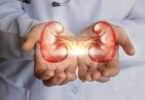Diabetes is a chronic condition in which blood sugar levels are very high and over time causes damage to the heart, blood vessels, kidneys, nervous system, and eyes.
Early symptoms of diabetes:
- Need to urinate very often.
- Constant hunger.
- Endless thirst.
- Incomprehensible weight loss.
- Constant tiredness and weakness.
- Sudden mood swings.
- Nervousness.
- Nausea and vomiting.
- Increased thirst and the urge to urinate.
- Increased appetite.
- Fatigue.
- Blurry vision.
- Numbness or tingling in the hands or feet.
- Ulcers that do not heal.
When there is not enough insulin or cells stop responding to insulin, too much sugar remains in the bloodstream which can cause serious health problems.
- Blood vessel damage occurs most often in the eyes, heart, nerves, feet, and kidneys.
- The kidneys are full of tiny blood vessels.
- Having kidney disease is very serious, even without diabetes.
Diabetes can make it hard to control your blood pressure and cholesterol.
This can lead to heart attack, stroke, and other problems. It can make it harder for blood to flow to the legs and feet.
Diabetes can cause cloudy urine when too much sugar builds up in the urine. This can cause the urine to smell sweet or fruity. Also, diabetes can lead to kidney complications or increase the risk of urinary tract infections, which can also cause urine to appear cloudy.
Excess glucose in the blood causes hardening of the arteries atherosclerosis, which can lead to heart attacks, strokes and/or poor circulation in the feet.
Heart disease is the leading cause of diabetes-related death.
The patient with this disease should avoid eating fried foods and other foods rich in saturated and trans fats, foods with a high salt content, baked goods, sweets, and ice creams. Beverages with added sugars, such as juices, sodas, and regular sports or energy drinks. White bread, rice, and pasta are processed foods high in carbohydrates, and other refined flour foods have been shown to significantly increase blood sugar levels in people with type 1 and type 2 diabetes.








